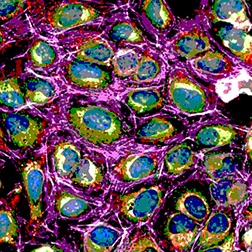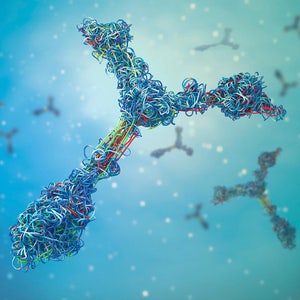
Unlock therapeutic targets and biomarkers, from identification to patient stratification
Identifying a crucial target with potential clinical relevance is a foundational yet challenging task in drug discovery. Most disease pathologies are regulated by intricate networks of genes with complex, and often parallel, regulatory pathways, complicating the selection of the most impactful points for therapeutic intervention and contributing to its high failure rate and expense.
Functional genomic screening using CRISPR, RNAi, and base editing can address these challenges by providing deep genetic insights that, dependent on your application, can help uncover novel synthetic lethal targets, provide an understanding of your therapeutic’s mechanism of action, stratify patients for responders and non-responders, and explore drug repurposing or combinational treatment strategies.
Applying functional genomic screening should be crucial to your drug development strategy, whether you want to take a therapeutic to market or build an evidence base to support your target or lead compound.
Revvity's FGS platforms
Our integrated functional genomic screening CRO-style services are designed to enhance decision-making and help to increase the likelihood of clinical trial success by delivering comprehensive datasets to guide your strategy. With a full suite of technologies, including CRISPR knockout, CRISPR activation, CRISPR inhibition, Pin-point™ base editing platform, and RNAi, our screening platform offers a comprehensive approach, whether using cell lines or primary cell cultures, to empower you to confidently navigate the complexities of drug discovery.
Our preclinical CRO functional genomic screening services
We can perform pooled and arrayed screens, from unbiased whole-genome exploratory screens to multiplexed or single-cell screens for complex mechanism of action analysis using either cell lines or primary immune cell cultures. Additionally, with our flexible Dharmacon™ library technologies and formats which can be tailored to fit your assay question and budget, coupled with a myriad of assay readouts, Revvity's preclinical services for functional genomic screening can offer the right solution for your project with confidence and physiological relevance.
Explore the range of gene modulation and functional genomic services

Functional genomic screening for target identification
Expand your gene perturbation with high-throughput screening capabilities.
A functional genomic approach using CRISPR or RNAi connects gene perturbations to phenotypes, with pooled screening offering a robust, unbiased way to analyze thousands of genes simultaneously.
Expand your gene perturbation with high-throughput screening capabilities.
A functional genomic approach using CRISPR or RNAi connects gene perturbations to phenotypes, with pooled screening offering a robust, unbiased way to analyze thousands of genes simultaneously.
In modern drug discovery, target identification requires a resource-intensive approach to identify and build confidence in novel targets. This becomes additionally challenging in primary cell systems, where non-immortalized cells are used, and cell numbers may be limiting, making data more variable. Functional genomics screening can provide scale, flexibility, and highly significant hits to help build confidence in your novel targets.
Revvity's functional genomic screening service offering addresses these challenges with its reproducible and functionally relevant screening tools, allowing researchers to harness disease relevant cell line models and primary immune cells for therapeutic advancement.
- Pooled CRISPR screening: Easy scalability up to the whole genome for agnostic approaches for lower complexity phenotypes.
- Arrayed CRISPR and RNAi screening: Build complexity through the ability to measure multiplexed readouts, unraveling complex biological interactions.
Why pooled CRISPR screening is important for target identification?
Pooled CRISPR screening is essential for unbiased target identification because it systematically knocks out each gene in the genome, allowing for comprehensive and high-throughput analysis. This method does not require prior knowledge of gene involvement, enabling the discovery of novel targets. It provides functional insights by observing the effects of gene knockouts on various phenotypes and is adaptable to different cell types and conditions, making it a versatile tool in drug discovery and biomedical research.
What is an arrayed CRISPR screening?
It is a genetic screening approach that employs CRISPR-Cas9 gene-editing technology to systematically disrupt or "knock out" specific genes. In an arrayed screening setup, in each sample a single gene is targeted, enabling in-depth analysis of that specific gene with multiplexed readouts, including viability, surface and intracellular markers (FACS or high content imaging), and protein quantification (HTRF™). The automation of our high-throughput platform allows for rapid screening, even when complexity increases.
Learn more how Revvity can help your drug development with the following resources:

Functional genomic screening for target validation
Confirm putative screen hits to drive precise and effective therapeutic breakthroughs
Functional genomic screening supports target validation by identifying and confirming the roles of specific genes in disease mechanisms, aiding in the discovery of more effective drugs.
Confirm putative screen hits to drive precise and effective therapeutic breakthroughs
Functional genomic screening supports target validation by identifying and confirming the roles of specific genes in disease mechanisms, aiding in the discovery of more effective drugs.
Functional genomic screening can impact target validation regardless of how putative screen hits have been identified. The versatility of the technologies and their application, alongside the high quality of data functional genomic screens, can help build confidence in novel hits while reducing the risk of chasing ineffective hits or false positives during the crucial early stages of drug development.
Functional genomic screens, such as CRISPR or RNAi screens, can verify whether a gene is essential for a particular phenotype. By systematically knocking out, knocking down, or over-expressing genes, you can interrogate phenotypic changes from multiple angles, building confidence in putative hits while also building an understanding of the mechanism.
Some genes may have redundant functions, meaning others can compensate for their loss. Functional screens can identify such redundancies, ensuring that the selected targets are essential and not compensated by other genes. Alternatively, functional genomics can be adapted to perturb multiple genes at once to investigate redundant gene networks specifically.
With our FGS CRO services, these screens can be conducted on a large scale, testing thousands of genes simultaneously. This high-throughput capability allows for rapidly identifying viable targets while filtering out non-viable ones. They can also be conducted at smaller scales with high complexity. For example, RNAseq-linked CRISPR screening (CROPseq, CITEseq, etc.) can be applied to deeply understand a few high-confidence targets.
Learn more how Revvity can help your drug development with the following resources:

Functional genomic screening to unveil mechanism of action
Understand precisely how your compound works in cells
Functional genomic approaches can be used to determine which gene perturbations influence the drug sensitivity or the development of acquired resistance due to prolonged drug treatment.
Understand precisely how your compound works in cells
Functional genomic approaches can be used to determine which gene perturbations influence the drug sensitivity or the development of acquired resistance due to prolonged drug treatment.
Functional genomic screening is a powerful tool for uncovering gene interactions and biological pathways essential for achieving therapeutic synergy or understanding the mechanism of action.
Techniques such as RNAi, CRISPR knockout, CRISPR activation (CRISPRa), and CRISPR inhibition (CRISPRi) allow gene expression modification, providing valuable insights into specific gene interactions that drive therapeutic effectiveness and biological activity. Additionally, functional genomic screening helps identify the clinical synergies needed to optimize treatment outcomes and target the right patient populations, given the biological differences between gene knockout and gene expression modification.
Revvity's drug-gene interaction screening
Dual-direction screening involves pairing CRISPRa with a loss-of-function method, such as CRISPR knockout (CRISPRko) or CRISPR inhibition (CRISPRi). Combining gene-modulation technologies allows assessment of gene ablation and gene overexpression, meaning researchers can identify opposing phenotypic effects and gain deeper insights into biological pathways and mechanisms of action.
Revvity's Dual screen CRISPRi/a service leverages the expertise used to perform whole-genome CRISPR screens and combines them into one service that allows for the identification of drug-gene interactions through paired gene perturbation analysis.
Learn more how Revvity can help your drug development with the following resources:

Functional genomics for high-content phenotypic screening
Correlate complex cellular phenotypes to genome profiles at high throughput.
Identify compounds with desired effects by evaluating their overall impact on biological systems using advanced imaging and data analysis.
Correlate complex cellular phenotypes to genome profiles at high throughput.
Identify compounds with desired effects by evaluating their overall impact on biological systems using advanced imaging and data analysis.
Traditional high-content screening often focuses on specific, pre-defined features to identify drugs or targets that influence a particular phenotype. This approach relies on researchers having a prior assumption about the phenotype that they are interested in. As a result, most imaging studies extract only one or two cellular features, leaving a wealth of valuable quantitative data about the cellular state unexplored.
By utilizing powerful data-intensive technologies like High-Content Imaging (HCI) image cytometry, it possible to significantly enhance our understanding of phenotypes linked to the genome with comprehensive and detailed insights into cellular behaviors and characteristics.
Advantages of phenotypic functional genomic screening:
- High-Content Imaging and image cytometry collect extensive data from thousands of cells, analyzing multiple parameters simultaneously for a more complete view of cellular phenotypes.
- These technologies provide high-resolution, single-cell data to detect subtle phenotypic changes and better understand genetic modifications.
- They enable unbiased screens that identify a wide range of phenotypic responses without relying on predefined assumptions, leading to unexpected discoveries.
- Combining these data with genomic information helps correlate genetic variations with phenotypic outcomes, crucial for understanding diseases and identifying novel drug targets.
- Analyzing multiple phenotypic parameters reveals complex pathways and mechanisms of action, providing a deeper understanding of gene and drug interactions.
Learn more how Revvity can help your drug development with the following resources:

Single cell transcriptomics services
Interrogate the phenotype of given genetic perturbations in detail
With CRISPRsc you can combine the flexibility of pooled and arrayed screening with the power of transcriptomics at single cell resolution.
Interrogate the phenotype of given genetic perturbations in detail
With CRISPRsc you can combine the flexibility of pooled and arrayed screening with the power of transcriptomics at single cell resolution.
Identifying the genetic factors that cause variability in cellular reactions to drugs is crucial to gaining a deeper understanding of drug responses and the development of treatment resistance.
What is CRISPR single cell?
CRISPR single-cell (CRISPRsc) technology facilitates the discovery of critical regulators within a treated cell population, highlighting the genetic drivers of drug responses and interactions unique to specific cell subsets. This technology can be applied to pooled or arrayed screens, merging the flexibility of functional genomic screening with the detailed insights of single-cell transcriptomics and proteomics. By linking guide RNAs to whole-transcriptome and surface protein expression data at the single-cell level, CRISPRsc offers the ability to examine the phenotypic effects of genetic changes in detail.
Single-cell analysis can provide detailed insights essential for tackling complex biological questions. This method provides high-resolution data, allowing us to examine how genes behave at the single-cell level closely. It helps specify key regulators crucial for understanding how genes interact in individual cells.
Single-cell analysis offers unbiased phenotypic mapping and shows how different cell types react to various conditions. This is especially useful for analyzing drug responses, revealing drug effectiveness and resistance differences. When combined with transcriptomics and proteomics, the single-cell analysis uses guide RNA to direct perturbations. It integrates this with whole-transcriptome and proteomic data, giving us a more complete picture of cellular responses.
Revvity's single-cell CRISPR screens
- Perform high-definition screens
- Generate ultra-rich perturbation-linked whole-transcriptome and proteomic readouts
- Distinguish cell subpopulation-specific gene responses to perturbation
Why use single-cell CRISPR screens?
- Study variation in cellular differentiation pathways
- Characterize cell subpopulations
- Identify gene interactions and networks
- Understand cellular resistance in detail
Explore more with the following resources:
You may also be interested in
Featured resources
Are you looking for resources, click on the resource type to explore further.










































